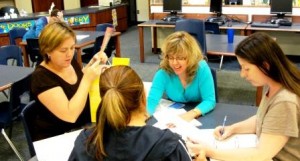
Yesterday’s blog gave the first half of tips and “aha” moments from participants in Tabor Rotation Training of Trainers Institutes. Here’s the second half. may they encourage you to try using small-group, differentiated instruction in your school.
Tip #16: Every learner ‘s brain craves moving from the concrete to the pictorial to the abstract. I need to make sure I do this in Teacher Time and in Readiness Groups each week.
Tip #17: I like calling the Teacher Time table and the table where I meet with students for guided math instruction the WHISPER TABLE. I may even meet with students for no reason at the WHISPER TABLE just for fun!
Tip #18: Tiering isn’t really that difficult. You just take an on grade level assignment. Think of the key concepts and skills in it, then simplify for the students who might not understand how to do it and sophisticate for the students who will already know how to do it.
Tip #19: Planning is the most important part of successful use of Tabor Rotation. This isn’t something you can do on Sunday night or on the way to school that morning…
Tip #20: You can’t say you’re trying to do small groups in math the right way. It’s like standing up. You can half-way stand up. You either stay sitting or you get up. You either do Tabor Rotation or you don’t. You can’t half-way do it!
Tip #21: Assessment is critical! If you create the unit’s final assessment, then the pre-assessment, you’ll start with the end in mind and focus your attention on what needs to be learned. And, this justifies my results!
Tip #22: Although learning all 14 Essential Elements of Tabor Rotation and how to plan for a full week of Tabor Rotation is challenging at first, with an open mind and clear vision for student improvement, the training will be the most valuable time you’ve ever spent!
Tip #23: Planning for Tabor Rotation helped our teachers work better as a team. Everyone has ownership for the learning of all of our students.
Tip #24: By putting in Team Roles and Leadership Academy into our classrooms, our students are learning responsibility, collaboration, and personal accountability.
Tip #25: Readiness groups can’t be skipped. I tried that last year because I thought I was doing enough just by having math stations. My students need time and attention “where they are.” Readiness groups are essential!
Tip #26: Teacher Time is my students’ favorite part of Tabor Rotation. They told me that my class is the one time during their day that a teacher actually listens to them. If you do nothing else, find a way to have Teacher Time with your students!
Tip #27: There’s a reason why the 14 Essential Elements are called “essential.” If you do all of them it makes a difference.
Tip #28: Planning for Tabor Rotation has helped my team organize their instruction so that it is specific, informed, and focused. I feel empowered!
Tip #29: This is the platform I’ve been looking for to help me and my team make small groups work. It’s like Microsoft Windows…for our math program.
Tip #30: Tabor Rotation will cause a paradigm shift. It will challenge what teachers know and force them to truly reflect and collaborate, but it is well worth the obstacles and challenges.

